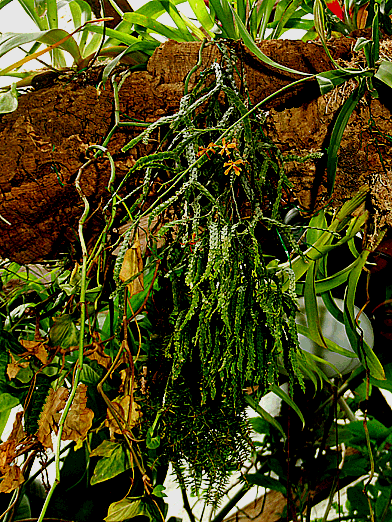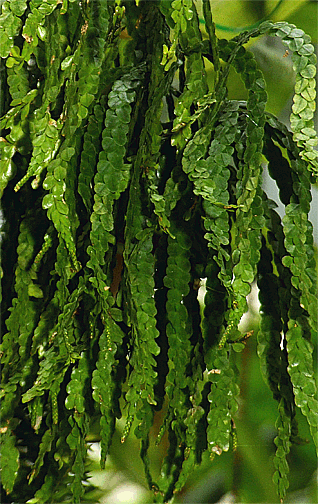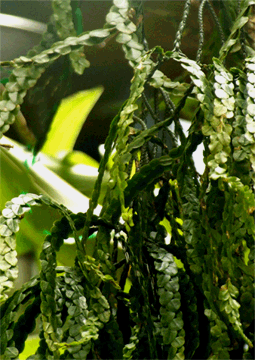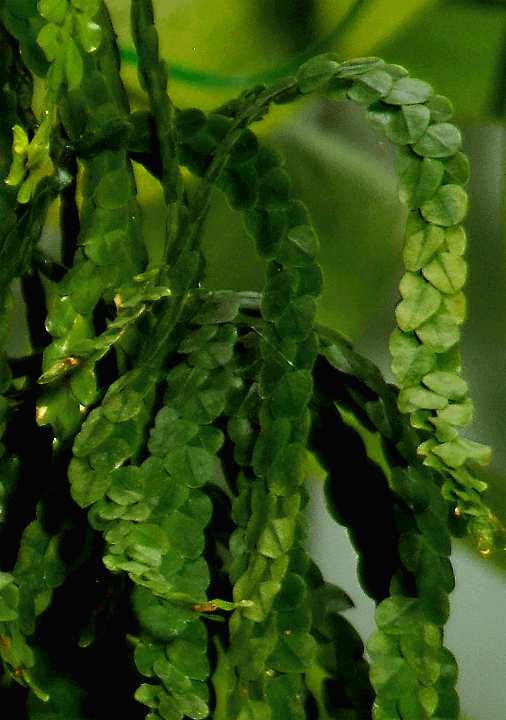|
|
|
Huperzia nummulariifolia
(Blume) Chambers, Jermy &
Crabbe
 Huperzia nummulariifolia (Blume) Chambers, Jermy & Crabbe Basionym: Lycopodium nummularifolium Blume Synonym: Phlegmariurus nummularifolius Non-scientific names found on the internet: Huperzia nummularifolius (non-scientific) Lycopodium nummularifolia (non-scientific) Common names: Tassel Fern, Club Moss, Fir Moss
The species Huperzia
nummulariifolia can be extremely confusing if
you are attempting to find scientific facts or are
doing casual research. Published In Acta Botanica
Yunnanica 3 in1981, Huperzia nummulariifolia is
commonly known, even by the pteridologists who study
these species, by other names. But within
professional pteridologist's circles it is now known
and accepted as Huperzia nummulariifolia.
The species is found on the peninsula of Malaysia (
Kedah, Peneng Island, Kelantan, Pahn, Johor), Java,
Sumatra, and in Thailand. Plants within the
genus Huperzia have been used by Chinese
medicine makers to make a tea that has been used for
hundreds of years as a diuretic, purportedly for
blood loss and other traditional medicinal purposes.
Traditional Chinese believe these plants cause the
loss of excess body fluids and supposedly people who
suffer from Alzheimer's disease claim a significant
return of memory after taking a derivative of
certain species twice a day for weeks at a time.
Whether the "medicine" truly works is not a known
scientific fact. Herbalist medicines are even
available for sale inside the United States created from some species
within the genera .
When I began to
research this species I was almost literally running
in circles. At first I found the name as Huperzia
nummulariifolia but then other sources
indicated the species name to be Phlegmariurus
nummularifolius, Huperzia
nummularifolius and Lycopodium nummularifolia
Both
of later are not scientifically published names.
Garden websites were even worse and more than
once listed names that do not exist in science.
Finally, when I checked the International Plant names Index (IPNI, a service of the Royal Botanic Gardens, Kew in London) that source indicated
the basionym (base name) to be Lycopodium
nummularifolium Blume. As of early
June, 2008, TROPICOS (a service of the Missouri Botanical Garden) still did not have the species
name Huperzia
nummulariifolia listed. When I
attempted to
confirm the
 correct name with pteridologist Dr. Robbin C.
Moran of the New York Botanical Garden he indicated
the name used by most pteridologists to be
correctly Huperzia nummulariifolia
(Blume) Chambers, Jermy & Crabbe. It
would be an understatement to say the
discrepancies found were confusing. correct name with pteridologist Dr. Robbin C.
Moran of the New York Botanical Garden he indicated
the name used by most pteridologists to be
correctly Huperzia nummulariifolia
(Blume) Chambers, Jermy & Crabbe. It
would be an understatement to say the
discrepancies found were confusing.
So I
again asked Dr. Moran for additional information
and received this response, "You
are correct: the basionym is Lycopodium
nummulariifolium Blume. I suggest using Huperzia
because that is being done by most
pteridologists these days. Huperzia differs from
the other Lycopodium segregates most
conspicuously by its equally forked branches." As
a result,
it is now established within botanical science
the basionym is correctly Lycopodium nummulariifolium
but the correct scientific species name
is Huperzia nummulariifolia.
Lycopodium nummulariifolium was simply the
first published name for the species, but
current research has reclassified the plant to
another genus which is more accurate due to
physical characteristics.
Within the rules of
botany, the first name correctly published as to
the correct genus becomes the true basionym or base
name. All other published names become synonyms
or simply the same species with another name.
The
more recent trend within science has been to
define Lycopodium
more narrowly and to reclassify the species into several genera
including Huperzia which is a member of the
Huperziaceae.
Possibly a
more in-depth explanation is necessary to explain
the currently accepted species' name when compared
to the originally published basionym. Plant expert
Leland Miyano explains,
"I
agree that the basionym of Huperzia nummulariifolia
is Lycopodium nummulariifolium. What I have been
attempting to explain is that the genus often
changes with new revisions. If you go to the IPNI
website now, it recognizes Huperzia nummulariifolia
as the current name. The basionym is only the
first officially accepted name that was
published....and often the genera changes on the
basionyms."
 Commonly found on
the internet as both a Huperzia and a
Phlegmariurus species in addition to several
fictitious names, plants in these genera are Lycophytic
plants. They are often known as Fir mosses or Fir
club mosses. The trend among pteridologists in
recent years has been to treat these plant
species in a separate genera based on specific plant
characteristics. But until the world of the
internet catches up to science, the confusion over
the name of this species is likely to continue. I
am left to use only the currently accepted
scientific name which is Huperzia
nummulariifolia. Commonly found on
the internet as both a Huperzia and a
Phlegmariurus species in addition to several
fictitious names, plants in these genera are Lycophytic
plants. They are often known as Fir mosses or Fir
club mosses. The trend among pteridologists in
recent years has been to treat these plant
species in a separate genera based on specific plant
characteristics. But until the world of the
internet catches up to science, the confusion over
the name of this species is likely to continue. I
am left to use only the currently accepted
scientific name which is Huperzia
nummulariifolia.
The common name
"fir moss" is used for tropical as well as some of
the temperate species. The term refers to their
resemblance to branches of a fir tree which is a
conifer. In Australia these epiphytic (tree
dwelling) species are known as the tassel ferns.
However, scientifically they are not ferns. An
epiphyte (ep-a-FIT) is simply a plant which grows attached to
another plant, normally a rain forest tree in the
case of the species Huperzia nummulariifolia.
Fir mosses grow in clusters rather than running on the ground which sometimes adds to the confusion within the species placement. The roots are produced in the tips of the shoots growing downward and sometimes emerge at soil level. Current botanical work now prefers to split Huperzia into two genera: Huperzia and Phlegmariurus. Since Huperzia nummulariifolia is a tropical to subtropical species of epiphytes other pteridologists appear to have some difficulty with the placement Thus the placement in some forums in the genus Phlegmariurus.
Scientists
believe plants within the broader group Lycopodiopsida
were a dominant group during the Carboniferous
Period. The Carboniferous Period is thought to have
occurred some 354 to 290 million years ago during
the Palaeozoic Era. The term comes from England and
applies to the deposits of coal which occur in that
region. Those deposits occur throughout portions of
Europe and Asia as well as well as the Midwestern
and eastern regions of North America. "Carboniferous"
is used to differentiate between the regions that
bear coal and the zones of eastern North America separated
by the Mississippi River. During that period this
and other club mosses were considered capable of
reaching the size of a tree. As a group, they are
thought to have been one source of the deposits of
coal found around the world.
Although
Lycopodiaceae do in fact somewhat resemble
mosses, they are considered to be substantially more
advanced due to a vascular form. Simply, the term
"vascular" refers to the highly specialized fluid
conducting tissues found within species such as
Huperzia nummulariifolia. Within tropical rain
forests the club mosses are found in moist regions
both in tropical and subtropical forests. However,
the species within this class are still often
loosely grouped as fern allies even though they are
not ferns.
 Dr. Moran
recommends two books for those interested in species in
these as well as fern genera: "One
is about fern cultivation: Fern Grower’s Manual
(with first author Barabara Joe Hoshizaki) and the other is
A Natural History of Ferns (Timber Press,
2004). The latter is a popular non-technical) book about
ferns and lycophytes. It is not an identification guide, but
tells about what ferns are doing in nature. Many of the
things you mention on your web page for H. phlegmaria are
also discussed in that book." Dr. Moran
recommends two books for those interested in species in
these as well as fern genera: "One
is about fern cultivation: Fern Grower’s Manual
(with first author Barabara Joe Hoshizaki) and the other is
A Natural History of Ferns (Timber Press,
2004). The latter is a popular non-technical) book about
ferns and lycophytes. It is not an identification guide, but
tells about what ferns are doing in nature. Many of the
things you mention on your web page for H. phlegmaria are
also discussed in that book."
The species
Huperzia
nummulariifolia
is so intricately designed by nature it
actually "appears" to be an intertwined "rope" but close
examination of close-up photographs reveals it is simply
intricate scale like plates.
The species reproduces by the production of
spores and those are in kidney shaped sporagia found
individually on the stem at the bases of unmodified leaves.
The species has many variations which often cause it to be
difficult to come to an immediate species determination.
Natural variation is common within many plant species although
it is poorly understood by the majority of plant collectors.
Although the explanation given in this link deals with other
genera, the scientific principle of natural variation are one
and the same. You may find you can better understand
variation after reading this link:
Go here.
Our specimen grows as an epiphyte hanging
from our epiphytic tree at the entrance to our ExoticRainforest
tropical atrium. The specimen was a gift from collector Teri
Baber. It is watered daily by an overhead misting system, twice
each day. Collectors report the species requires a high
nitrogen fertilizer to prosper. The species is sometimes
available for sale but often with the wrong scientific name and
can be quite costly.
On June 2, 2008 I requested a verification of
the identification of the species shown on this page from Dr, Robbin
C. Moran, Ph.D., Curator of Ferns at The New York Botanical
Garden. He verified the plant in our photos to be
Huperzia nummulariifolia
(Blume) Chambers, Jermy & Crabbe.
My sincere appreciation to Dr. Moran as well as Leland Miyano
for their assistance in gathering the information found on this
page.
|